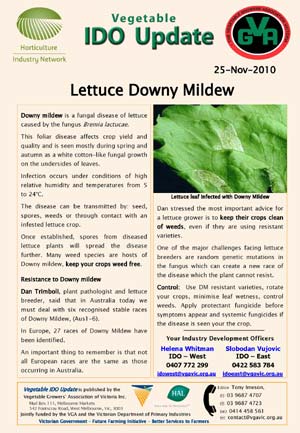|
|
Downy mildew is a fungal disease of lettuce caused by the fungus Bremia lactucae. This foliar disease affects crop yield and quality, mostly occurs during spring and autumn appearing as white cottony-like fungal growth, on the undersides of leaves. Infection occurs under conditions of high relative humidity and temperatures from 5 to 24°C. The disease can be transmitted by seed, spores, weeds or through contact with an infested lettuce crop. Once established, spores from diseased lettuce plants will spread the disease further. Many weed species are hosts of Downy mildew, keep your crops weed free. Resistance to Downy mildew : Dan Trimboli, plant pathologist and lettuce breeder, said that in Australia today we must deal with six recognised stable races of Downy Mildew, (Aus1-6). In Europe, 27 races of Downy Mildew have been identified. An important thing to remember is that not all European races are the same as those occurring in Australia. Dan stressed the most important advice for a lettuce grower is to keep their crops clean of weeds, even if they are using resistant varieties. One of the major challenges facing lettuce breeders are random genetic mutations in the fungus which can create a new race of the disease which the plant cannot resist. Mildew Control :
SEE ALSO : For more information contact your Industry Development Officers :
|
|

